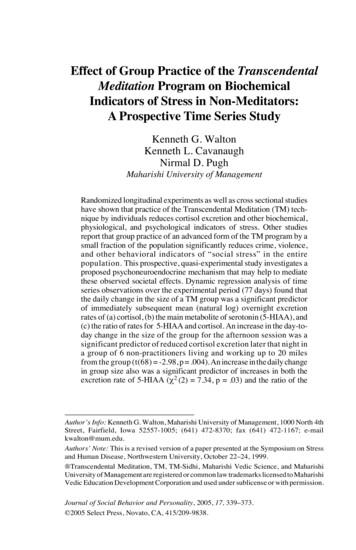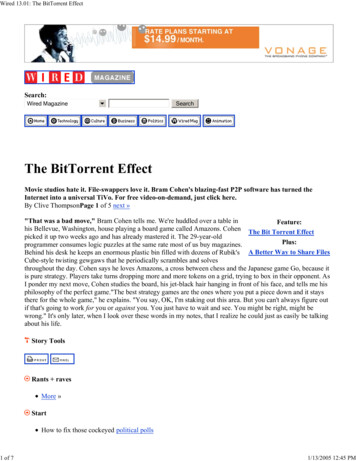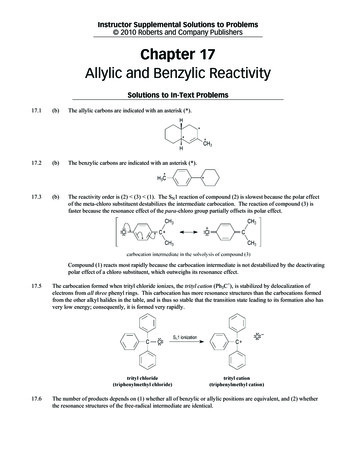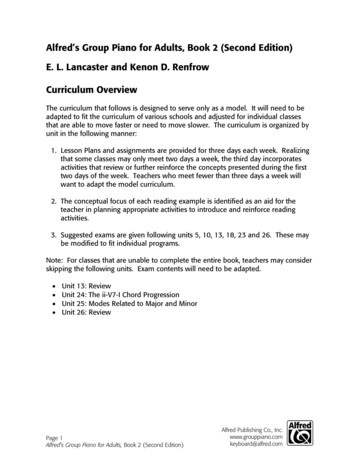
Transcription
Walton et al.GROUP TM PROGRAM AND SOCIAL STRESS339Effect of Group Practice of the TranscendentalMeditation Program on BiochemicalIndicators of Stress in Non-Meditators:A Prospective Time Series StudyKenneth G. WaltonKenneth L. CavanaughNirmal D. PughMaharishi University of ManagementRandomized longitudinal experiments as well as cross sectional studieshave shown that practice of the Transcendental Meditation (TM) technique by individuals reduces cortisol excretion and other biochemical,physiological, and psychological indicators of stress. Other studiesreport that group practice of an advanced form of the TM program by asmall fraction of the population significantly reduces crime, violence,and other behavioral indicators of “social stress” in the entirepopulation. This prospective, quasi-experimental study investigates aproposed psychoneuroendocrine mechanism that may help to mediatethese observed societal effects. Dynamic regression analysis of timeseries observations over the experimental period (77 days) found thatthe daily change in the size of a TM group was a significant predictorof immediately subsequent mean (natural log) overnight excretionrates of (a) cortisol, (b) the main metabolite of serotonin (5-HIAA), and(c) the ratio of rates for 5-HIAA and cortisol. An increase in the day-today change in the size of the group for the afternoon session was asignificant predictor of reduced cortisol excretion later that night ina group of 6 non-practitioners living and working up to 20 milesfrom the group (t(68) -2.98, p .004). An increase in the daily changein group size also was a significant predictor of increases in both theexcretion rate of 5-HIAA (χ 2 (2) 7.34, p .03) and the ratio of theAuthor’s Info: Kenneth G. Walton, Maharishi University of Management, 1000 North 4thStreet, Fairfield, Iowa 52557-1005; (641) 472-8370; fax (641) 472-1167; e-mailkwalton@mum.edu.Authors’ Note: This is a revised version of a paper presented at the Symposium on Stressand Human Disease, Northwestern University, October 22–24, 1999. Transcendental Meditation, TM, TM-Sidhi, Maharishi Vedic Science, and MaharishiUniversity of Management are registered or common law trademarks licensed to MaharishiVedic Education Development Corporation and used under sublicense or with permission.Journal of Social Behavior and Personality, 2005, 17, 339–373. 2005 Select Press, Novato, CA, 415/209-9838.
340APPLICATIONS OF MAHARISHI VEDIC SCIENCEexcretion rates of 5-HIAA to cortisol (t(69) 4.56, p .0001). Thesefindings are consistent with those of a prior time series quasi-experimentthat examined 5-HIAA excretion in another sample of individualsoutside the group. Thus the results of the current study support thehypothesis that group practice of the TM program reduces social stressby producing beneficial neuroendocrine effects in non-meditators outside the group.Over 40 studies have reported reductions in crime, violence, andother indicators of “social stress” due to daily group practice of theTranscendental Meditation (TM) technique (and its more advancedaspect, the TM-Sidhi program) by a small fraction of the population(Dillbeck, 1990; Hagelin, Rainforth, Orme-Johnson, Cavanaugh, &Alexander, 1999; Orme-Johnson, 2003; Orme-Johnson, Alexander,Davies, Chandler, & Larimore, 1988). An annotated bibliography ofthese studies is available online (Maharishi University of Management,1999). This type of effect was predicted over 30 years ago by MaharishiMahesh Yogi, founder of the TM program (Dillbeck, Cavanaugh, Glenn,Orme-Johnson, & Mittlefehldt, 1987). The “Maharishi Effect,” as it hascome to be known, appears to defy explanations based on ordinarysocial interactions and has been cited as evidence for the field nature ofconsciousness (Dillbeck, 1990; Dillbeck et al., 1987; Hagelin et al.,1999; Orme-Johnson et al., 1988). The present study investigatesstress-related neuroendocrine changes in non-meditating members ofthe population that may mediate the observed beneficial effects onsocial behavior.Stress is both an individual and a social phenomenon. On theindividual level, it may be defined as the physiological changes produced by challenging conditions or “stressors.” One leading authority(Sapolsky, 1992, p. 8) defines stressors as “physiological or psychological perturbations that throw us out of homeostatic balance ” and thestress-response as “the set of neural and endocrine adaptations that helpus reestablish homeostasis.” In most cases the stress-response involvesactivation of the hypothalamic-pituitary-adrenocortical (HPA) axis, resulting in increased secretion of the glucocorticoid cortisol, often referred to as the principal “stress hormone.” While increases in cortisolare often protective and adaptive in the short run, persistent activation ofthe HPA axis can cause a prolonged elevation of cortisol that is damaging to health. Extreme, prolonged, or chronic intermittent stress is knownto cause long-lasting changes in the HPA axis and other systems ofneuroendocrine regulation, resulting in detrimental health consequencesand maladaptive behaviors. Many of the latter can be traced to excess
Walton et al.GROUP TM PROGRAM AND SOCIAL STRESS341levels of cortisol or other glucocorticoids (McEwen, 1998; Sapolsky,1992; Seeman, Singer, Rowe, Horwitz, & McEwen, 1997).On the societal level, stress incurred by individuals gives rise tosocial stress. Social stress has been defined operationally in terms ofdifferences between communities or societies in the level of specificstressful life events or social stressors. Such stressors include unemployment, disasters, divorce, bankruptcies, strikes, etc., which, in turn, cannegatively influence individuals in society, increasing the incidence ofillness, suicide, crime, aggression, violence, and other social outcomes(Linsky, Bachman, & Straus, 1995; Linsky & Straus, 1986). Like stressors on the individual level, evidence suggests that social stressorsproduce their detrimental influence on individual behavior and healthpartly through altering the neuroendocrine mechanisms maintaininghomeostasis (Seeman & McEwen, 1996).In combating the problem of stress, then, an ultimate goal is torestore to optimal function these neuroendocrine mechanisms that maintain homeostasis. Programs that reduce or reverse the effects of stress inindividuals produce a variety of benefits to physical and mental health inthose individuals (e.g., Alexander et al., 1996; Castillo-Richmond et al.,2000; Orme-Johnson & Walton, 1998). The Transcendental Meditationprogram is the most extensively investigated of such programs, withover 600 studies reporting beneficial, stress-reducing effects (Jevning,Wallace, & Beidebach, 1992; Orme-Johnson & Walton, 1998).Several studies support the hypothesis that practice of the TMtechnique can reverse long-lasting effects of stress on neuroendocrineregulation, including reduction of cortisol excretion and other biochemical indicators of stress (Jevning, Wilson, & Davidson, 1978; Levitsky,1998; MacLean et al., 1997; Walton, Pugh, Gelderloos, & Macrae,1995). Decreased blood levels and excretion of cortisol were reported ina random-assignment, longitudinal study of TM practitioners (Levitsky,1998; MacLean et al., 1997). Increased excretion of 5-HIAA (5hydroxyindoleacetic acid), a major metabolite of serotonin, also hasbeen reported in individuals practicing the TM technique (Bujatti &Riederer, 1976; Walton et al., 1995). These increases were found to becorrelated with reductions in anger, anxiety, aggression and other negative emotions (Walton & Pugh, 2000). Cross-sectional comparison ofTM practitioners and non-meditating controls found that the ratio of5-HIAA to cortisol showed a greater difference between the two groupsthan was found for 5-HIAA or cortisol excretion alone (Walton & Pugh,2000). The biochemical changes described above have been linked todecreased health problems such as hypertension and heart disease(Alexander et al., 1996; Walton et al., 1995) as well as to reduced
342APPLICATIONS OF MAHARISHI VEDIC SCIENCEsubstance abuse and improved rehabilitation of criminal offenders (Waltonand Levitsky, 1994; Walton & Levitsky, 2003).The effects of the TM and TM-Sidhi programs in individual practitioners involve physiological, psychological, and behavioral changesthat are thought to be primarily due to periods of “transcending” occurring during the practices. In the process of transcending, the activethinking mind settles down to a state of restful alertness termed “transcendental consciousness,” a proposed fourth major state of consciousness with properties different from the states of deep sleep, dreaming,and ordinary waking (Jevning et al., 1992; Mason et al., 1997; Travis &Pearson, 2000; Travis & Wallace, 1997, 1999).Based on the understanding of consciousness available in the Vedictradition (from which the TM and TM-Sidhi programs are derived),transcendental consciousness has been equated with the unified fieldproposed by quantum field theory to underlie all matter and energy in theuniverse (Dillbeck et al., 1987; Hagelin, 1987). Both transcendentalconsciousness and the unified field display the fundamental quality ofself-interaction or self-referral and have been shown to exhibit manyother fundamental qualities that are the same (Hagelin, 1987, 1989).Further discussion of this field-theoretic conception of consciousness isprovided by Dillbeck et al. (1987), Orme-Johnson (2003), and OrmeJohnson et al. (1988).The field of transcendental consciousness is said to be enlivenedduring the TM and TM-Sidhi programs, not only in those who practicethem but also in others within the population who do not practice them(Maharishi Mahesh Yogi, 1975, 1986). Physiological evidence in support of the hypothesized field nature of consciousness has been reportedin electroencephalographic (EEG) studies (Orme-Johnson, Dillbeck,Wallace, & Landrith, 1982; Travis & Orme-Johnson, 1989).Because of the potential benefits of reduction in social stress throughthe group practice of these programs, there is a pressing need for a betterunderstanding of the mechanism mediating these changes. One possiblemechanism involves neuroendocrine changes similar to those reportedin individuals practicing the TM technique. According to the fieldtheoretic view of consciousness, the field of transcendental consciousness enlivened in individuals as they practice the TM and TM-Sidhiprograms also gets enlivened throughout society, especially by the grouppractice of these programs (Maharishi Mahesh Yogi, 1975, 1986). If thisfield-theoretic perspective is valid, and if the enlivenment of transcendental consciousness gives rise to beneficial neuroendocrine changes,
Walton et al.GROUP TM PROGRAM AND SOCIAL STRESS343then one would predict that individuals outside the group would exhibitbiochemical changes similar to those observed in TM practitioners.To produce a measurable effect of the group on society, the predicted critical threshold for the number of participants practicing the TMand TM-Sidhi programs together in a group (hereafter called “the TMgroup”) is the square root of 1% of the population (Dillbeck et al., 1987;Hagelin, 1987; Orme-Johnson et al., 1988). For the site of the currentstudy—the town of Fairfield, Iowa and the surrounding county (population 16,700)—the predicted number of group participants required tocreate measurable effects outside the group was 20–30. (For a relativelysmall town such as Fairfield, the square root of 3–5 % of the populationis the predicted requirement, rather than the square root of 1%, thethreshold applicable to larger populations.) This critical threshold wassubstantially exceeded on each of the 77 days of the study. During thisperiod, the average number of participants in the TM group for the dailyafternoon session was approximately 1400 (standard deviation 172). Themean daily change in group participation (absolute value) was 88, witha standard deviation of 80.Because the number of participants in the TM group never fellbelow the predicted critical threshold during the period of this study, itwas not possible to test the impact on the biochemical measures ofmovements in the size of the group from below to above threshold.Rather, the focus of this study was to empirically assess the impact offluctuations in the size of the TM group in a situation in which thenumber of group participants remained continuously above the predictedthreshold necessary to produce effects in individuals outside the group.The empirical analysis found that the change in the size of the TMgroup from the previous day was a significant predictor of the immediately subsequent overnight excretion rates of cortisol and 5-HIAA, aswell as the 5-HIAA-to-cortisol ratio. An increase in the day-to-daychange in the size of the afternoon TM-group session was a significantpredictor of decreased urinary cortisol excretion that same night. Suchincreases in the size of the group were also a significant predictor ofsubsequent increases in 5-HIAA excretion as well as in the 5-HIAA-tocortisol ratio. The finding that daily change in the size of the TM groupwas a significant predictor of the excretion rates for cortisol and 5-HIAAmay suggest some type of habituation response of the biochemicalvariables to the TM group size.The empirical results of the current study are consistent with those ofa previous time series quasi-experiment that investigated the influence
344APPLICATIONS OF MAHARISHI VEDIC SCIENCEof group practice of the TM program on overnight 5-HIAA excretion ina different sample of non-meditators (Pugh, Walton, & Cavanaugh,1988). These findings are also consistent with those of two previous timeseries studies that examined 5-HIAA excretion in TM-group participants(Pugh et al., 1988). Another time series study reported a significantpositive effect of the TM group on daytime 5-HIAA excretion in individuals participating in the group (Löliger, 1990).METHODSParticipants and DataParticipants in the TM group were students, faculty, and staff ofMaharishi University of Management in Fairfield, Iowa, and workingage adults living in the Fairfield area. Non-TM participants for theexperiment were individuals not practicing the TM technique who livedor worked in Fairfield or the surrounding area and who volunteered toparticipate in the study after being contacted through their employers.The six non-TM participants were two women clerical workers (oneaged 27 years and the other 50), an 18-year-old son of the 50-year-oldwoman, and three male factory workers (two aged 38 years and one, 41).Although the places of employment of all but the teenage male were inFairfield, only the 27-year-old woman and one of the factory workerslived inside the city limits. The towns where the others lived werelocated 12 to 20 miles from Fairfield.Nightly urine was collected for 77 consecutive days. To ensure thatthe measured metabolite of serotonin (5-hydoxyindoleacetic acid, 5HIAA) originated from serotonin synthesized endogenously, foods knownto contain substantial amounts of serotonin (e.g. bananas, walnuts, andavocados) were excluded from the diet. Urine collections were in bottlescontaining 10 grams of boric acid as preservative. The recorded startingtime was the last urination in the toilet before bed and ending time wasthe last collection upon rising in the morning. Total volumes weremeasured within 3 days and samples were stored at minus 20 degreescentigrade until assay.Urinary 5-HIAA was analyzed by spectrophotometric assay (Shihabi& Wilson, 1982). The method was supplemented by the simultaneoustesting of a sample of a urine pool (combining samples collected from 12participants) as an external standard. The interassay coefficient of variation was 5.9% for these urine pool samples. Cortisol was analyzed byradioimmunoassay using commercial kits (Diagnostic Products Corp.,Los Angeles) with an interassay coefficient of variation of 2–4%.In the statistical analysis, the 5-HIAA excretion rate was the meanovernight rate for the six non-meditating participants. The cortisol
Walton et al.GROUP TM PROGRAM AND SOCIAL STRESS345excretion rate used in the analysis was based on the pooled daily samplefor all six participants, with each participant’s contribution to the poolbeing proportionate to their overnight urine excretion rate (total urinevolume divided by the total hours of their collection period). Thus themeasured cortisol excretion rate was equivalent to a weighted mean forall six non-TM participants, with weights proportional to the total urineexcretion per hour for each participant. This method of forming the urinepool was chosen because the excretion of cortisol and most othersubstances is more closely associated with the duration of the collectionperiod than with urine volume. The correlation between rate of urineexcretion and rate of cortisol excretion was minimal (r .09, p .43),and therefore it is unlikely that the different urine volumes for eachparticipant had a significant influence on the mean cortisol rate.Data on daily participation in the TM group program were obtainedfrom the Capitol for the Age of Enlightenment, the nonprofit educationalorganization that was responsible for administering the TM group meditations in Fairfield. The afternoon group TM program began at 5:20 PMand typically ended between 6:00 and 6:30 PM. Thus the afternoongroup session ended approximately 4–5 hours before bedtime (the beginning of the overnight urine collection period for the non-meditatingparticipants) and approximately 12–13 hours before rising (the end ofthe collection period). Thus the afternoon TM group program for a givenday always temporally preceded the overnight collection period thatbegan later that same evening. Consequently, these data did not permitmeasurement of any possible contemporaneous (lag-zero) effect for theTM-group variable on the biochemical variables, and the shortest measured time lag for the TM variable is denoted as lag one.Attendance in the daily morning TM group program was not included in the analysis because the larger afternoon group session wasmuch closer in time to the overnight collection period, and thus might beexpected to show a stronger statistical relationship to the biochemicalmeasures. The morning group was substantially smaller in size (mean977 versus 1400 for the afternoon) and highly correlated (r .86) withafternoon attendance. The correlation between daily changes in themorning group attendance and daily changes for the afternoon sessionwas much lower (r .33).Statistical AnalysisTo examine the nature of possible causal relationships between thegroup practice of the TM program and the biochemical measures, weused a statistical procedure that has been frequently applied in theanalysis of time series data (Granger & Newbold, 1986; Hamilton, 1994;Kaufmann & Stern, 1997). Based on a definition of causality developed
346APPLICATIONS OF MAHARISHI VEDIC SCIENCEby Wiener (1956) and Granger (1969), the test for “Granger-causality”relies on the assumption that movements in a causal variable X shouldtemporally precede those in the variable Y that are caused by X. Inaddition to the assumption that the cause should precede the effect, thisapproach assumes that X should contain unique predictive informationabout Y not contained in past values of Y or other explanatory variables(Granger & Newbold, 1986). Thus a time series X is said to causeanother time series Y, in the sense defined by Granger and Wiener, if pastvalues of X are statistically significant predictors of current values oftime series variable Y, after controlling for the effect on Y of its own pastvalues and for past values of other important predictor variables.The existence of a causal relationship, as operationally defined byWiener and Granger, thus implies a statistical causal ordering, or predictive relationship, between two time series variables. The empiricalfinding of such a predictive relationship between variables does notnecessarily imply the existence of “true” causality as variously definedby philosophers of science (Zellner, 1979). Tests for a significant predictive relationship between two time series variables are unlikely toprovide useful information about a true causal relationship betweenthem if these variables are selected arbitrarily. However, such predictivetests may offer useful information about true causality when a causaltheory linking the two variables exists, and when that theory has testableimplications that can be framed in terms of one variable predictinganother (Hamilton, 1994). The tests for causal ordering also depend onthe set of conditioning variables used in the statistical analysis. Omissionof relevant variables may bias parameter estimates and affect the conclusions of the tests.The tests for causal ordering were based on ordinary least squares(OLS) estimates of linear regression equations that express each response variable as a function of its own past values and those of otherpredictor variables (Hamilton, 1994). Dynamic regression equations ofthe following form were estimated:LRATIOt a10 Σi a1i LRATIOt-i Σi b1i DTMt-i Σi c1i DTEMPt-i u1t , t 1, 2, . . . T; i 1, 2, . . . m(1)LCORTt a20 Σi a2i LCORTt-i Σi b2i DTMt-i Σi c2i LHIAAt-i Σi d2i DTEMPt-i u2t , t 1, 2, . . . T; i 1, 2, . . . m(2)LHIAAt a30 Σi a3i LHIAAt-i Σi b3i DTMt-i Σi c3i LCORTt-i Σi d3i DTEMPt-i u3t , t 1, 2, . . . T; i 1, 2, . . . m(3)In these equations, LRATIOt is the natural log of the ratio of mean5-HIAA excretion to mean cortisol excretion (multiplied by 10); Σi is the
Walton et al.GROUP TM PROGRAM AND SOCIAL STRESS347summation operator, with summation over time-lag i to maximum lag m;DTMt is the change in TM-group participation from the previous day forthe afternoon session (divided by 100); LCORTt is the natural log of themean cortisol excretion rate (µg/hr) at time t; LHIAAt is the natural logof the mean 5-HIAA excretion rate (µg/hr) (multiplied by 10); andDTEMPt is the change in average daily temperature from the previousday (divided by 10). The variables u1t, u2t, and u3t are independent andidentically distributed random error terms. The natural log transformation was used to reduce substantial positive skewness in the 5-HIAA andcortisol data as well as to stabilize their variances.The causality testing procedure may be illustrated as follows. Inequation (1), the series DTMt is said to cause the series LRATIOt, in thesense defined by Wiener and Granger, if the estimated regression coefficients on the lagged values of DTMt are jointly significantly differentfrom zero, indicating rejection of the null hypothesis of no causalordering. Causality tests for other variables are conducted in an analogous manner.In the three equations, all variables are expressed as (discrete) ratesof change. The change in average daily temperature was included in eachregression equation because serotonin (and to a lesser degree, cortisol)have been reported to be affected by temperature (Ghosh, Taneja,Malhotra, Kumar, & Ahuja, 1974; Sarrias, Artigas, Martinez, & Gelpi,1989). Use of the change in temperature, rather than temperature, wasmotivated on empirical grounds. Inclusion of the change in TM-groupparticipation as a predictor was suggested by previous empirical analysisof data on 5-HIAA excretion from three other time series quasi-experiments (Pugh et al., 1988). Use of the change in TM-group participationwas also supported by formal tests indicating that the changes appearedto be unambiguously stationary with respect to the mean.Following common practice (Granger & Newbold, 1986), the number of time lags for the predictor variables was empirically determinedusing an objective criterion for the selection of model order. The numberof lags was determined by minimization of the Bayesian InformationCriterion (BIC) (Schwarz, 1978), provided that the resulting regressionequation satisfied standard diagnostic tests, such as lack of serial correlation of residuals. The BIC criterion is defined as BIC T ln(s2) kln(T), where T is the number of observations, ln(s2) is the naturallogarithm of the maximum likelihood estimate of the variance of regression residuals, and k is the number of model parameters. The BIC seeksto provide a balance between the competing goals of model simplicity(parsimony) and precision of model fit. Minimization of the BIC hasbeen shown to yield asymptotically consistent estimates of model order
348APPLICATIONS OF MAHARISHI VEDIC SCIENCE(Enders, 1995). Models with up to a maximum time lag of 3 days for allexplanatory variables were considered.When the BIC criterion led to the selection of regression models thatincluded only one time lag for the explanatory variables, t-tests for theregression slope coefficients were used to test the null hypothesis of nocausal ordering. When more than one lag of each predictor was included,joint significance tests were used. On the basis of simulation studies,Wald tests have been recommended for such joint tests of causal ordering (Geweke, Meese, & Dent, 1983). The Wald test statistic was calculated as T(RSSc – RSSu)/RSSu, where T is the number of observations,RSSu is the residual sum of squares for the unconstrained regression, andRSSc is the residual sum of squares for the constrained regression(Geweke et al., 1983). The Wald statistic has an (asymptotic) chi-squaredistribution with degrees of freedom equal to the number of constrainedparameters.Prior to the regression analysis, the time series plot as well as thesample autocorrelations and partial autocorrelations for each responseand predictor variable were examined for evidence of stationarity. Constancy of mean and variance over time (covariance stationarity) isrequired for valid statistical inference. Stationarity for each series wasalso investigated using a formal test for “unit roots,” the Phillips-Perrontest (Phillips & Perron, 1988). The finding of a unit root in theautoregressive representation of the time series would indicate the presence of a non-stationary random walk (stochastic trend) component thatwould invalidate all standard statistical tests (Dickey & Fuller, 1979;Enders, 1995).The Phillips-Perron test for unit roots is based on OLS regressionestimates for the equation yt α γ yt-1 δ t εt. In this regression, ytis the variable to be tested for a unit root, yt is the first difference of yt,α is the regression intercept, γ is the slope coefficient for yt-1, δ is theslope coefficient for the deterministic time-trend variable t, and εt is arandom disturbance term that need not be serially uncorrelated andidentically distributed (Phillips & Perron, 1988). When the trend term inthis equation was not significant, the unit root test was based on theregression without the trend, to increase the power of the test (Enders,1995). In the regressions with or without trend, γ should be equal to zerounder the null hypothesis of a unit root.Critical values for testing the null hypothesis γ 0 were calculatedby MacKinnon’s (1991) response surface method. In the Phillips-Perronprocedure, standard errors and t-ratios for the regression estimates werecorrected for possible serial correlation in the disturbance εt using theNewey-West method (Newey & West, 1987).
Walton et al.GROUP TM PROGRAM AND SOCIAL STRESS349Following common practice (e.g. Kaufmann & Stern, 1997), seasonal dummy variables representing the different days of the week wereused, when required, to remove any significant serial correlation ofregression residuals at the seasonal lag of 7. Significant correlationbetween residuals 7 days apart indicates weekly seasonality in theregression residuals. Since each regression included an intercept, onlysix dummy variables were needed to allow the regression intercept todiffer for each day of the week (Harvey, 1990).A battery of diagnostic tests was applied to the estimated regressionequations to determine if other key assumptions of the statistical analysiswere satisfied. To detect possible serial correlation of the regressionresiduals, a Lagrange multiplier (LM) test was used, the BreuschGodfrey test (Breusch, 1978; Godfrey, 1978). The presence of eithersignificant serial correlation of the residuals or heterogeneity of residualvariance would result in inefficient parameter estimates and biased andinconsistent standard errors for the regression coefficients that wouldinvalidate standard hypothesis tests (Harvey, 1990; Ramanathan, 1998).LM tests were used to check for three different forms of heterogeneity of residual variance. Each test was based on an auxiliary regression(with a constant term) for which the squared residuals served as theresponse variable. To test whether the residual variance was systematically related to the fitted values for the original regression, the squaredfitted values served as the independent variable in the auxiliary regression (Pesaran & Pesaran, 1991). To detect possible heteroskedasticity ofthe regression residuals over time, the independent variable in theauxiliary regression was a linear time trend (Goodrich, 1989). To testwhether the residual variance was significantly related to one or more ofthe explanatory variables, the explanatory variables in the auxiliaryregression were all the predictors from the original regression, as well astheir squares and cross-products (White, 1980). These three tests forheterogeneity of variance are special cases of a general class of tests thathas been shown to be robust to non-normality of the residuals (Koenker,1981). Because the asymptotic chi-square version of the LM statistic forthese tests has been shown to reject the null hypothesis too frequently insmaller samples, the results for the heteroskedasticity and serial correlation tests are reported as an “LM F-statistic” (Charemza & Deadman,1997; Kiviet, 1986).Addit
Transcendental Meditation, TM, TM-Sidhi, Maharishi Vedic Science, and Maharishi University of Management are registered or common law trademarks licensed to Maharishi Vedic Education Development Corporation and used under sublicense or with permission. Journ











